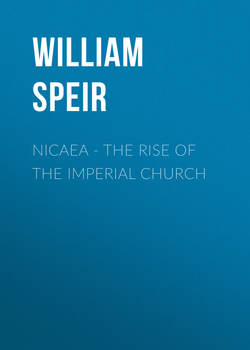Читать книгу Nicaea - The Rise of the Imperial Church - William Speir - Страница 7
На сайте Литреса книга снята с продажи.
ОглавлениеAuthor’s Notes
Arias of Baucalis is a fascinating historical figure. In all of my research, no one other than Judas Iscariot has been so vilified as has Arias. He has been called the anti-Christ and a heretic, possession of his writings was punishable by death, and he was considered to be so dangerous that he was exiled from the Roman Empire and then assassinated when the Emperor allowed him to return.
What was Arias’ crime? Why did he deserve such harsh treatment by historians over the centuries? He disagreed with other priests and bishops on key points of theology – points that the Roman Emperor wanted to become part of the theology of the churches.
Arias and his supporters stood up against an attempt to usurp church doctrine and transform the churches into a tool of statecraft, rather than allow them to remain institutions of salvation. In the end, Arias couldn’t withstand the might of the bishops in league with the Emperor. Because Arias lost the fight, and winners write the history books, Arias’ viewpoints have been altered and ridiculed by theologians and historians.
This book looks at Arias in a different light. Was he a good man whose principles didn’t allow him to go along with the Emperor and his supporters? Was he a sincere follower of the words and works of Jesus – a priest who wanted to preserve what he felt was the true religion of Christ? I believe that he was.
I have attempted to peel back the dogma and look at the central characters in the Arian controversy as real people, not as pious historical caricatures created by historians to delude the masses. I hope that I’ve been successful.
William Speir
June 2016
A Note on the Organization of the Early Churches:
The early Christian churches didn’t have the same structure as today’s religions. The early Christian churches, collectively, were a loose association of congregations that banded together for mutual interests and mutual protection (most congregations were under the constant threat of exposure and persecution at the hands of Rome and her provinces). The structure of the churches was based on service (serving the congregations, serving the acolytes, serving the priests, serving the bishops), not command or control. There was no “ruling” body (Pope, College of Cardinals, Apostolic Council, etc.).
Each church had a priest (or multiple priests if the congregation was large enough) and acolytes who were studying to become priests. Bishops were responsible for all churches in a specific geographic area, and they appointed priests and worked to ensure a level of consistency in the doctrine preached in the churches under their oversight. Five bishops (the bishops of Alexandria, Antioch, Constantinople/Byzantium, Jerusalem, and Rome) were the Patriarchs of the churches, and these senior theologians were responsible for appointing bishops, appointing their own successors, and settling theological disputes between the churches that the bishops couldn’t handle. Patriarchs and bishops had influence over the churches, but no absolute authority.
A Note on Scriptural Quotations and References:
The scriptural quotes and references used throughout this book are from the King James Version of the Holy Bible. Punctuation and capitalization used in quotes from this version of the Bible are preserved as is. While not a perfect translation of the original source material, it is the one Bible version that, in my opinion, has the least slant toward any one religious doctrine.
A Note on Locations:
The names of many cities mentioned throughout the book are the names they had during the time of Emperor Constantine I’s reign over the Roman Empire. The following gives their modern names:
Historic Name: Modern Name:
| Historic Name: | Modern Name: |
| Alexandria, Egypt | Alexandria, Egypt |
| Antioch, Greece | Antakya, Turkey |
| Arelate, Gaul | Arles, France |
| Barcino, Hispania | Barcelona, Spain |
| Baucalis, Egypt | Alexandria, Egypt |
| Byzantium (Constantinople) | Istanbul, Turkey |
| Carthago (Carthage) | Tunis, Tunisia |
| Córdoba, Hispania | Córdoba, Spain |
| Ephesus, Greece | Selçuk, Turkey |
| Gades, Hispania | Cádiz, Spain |
| Illyricum | Split, Croatia |
| Jerusalem, Judea | Jerusalem, Israel |
| Nicaea, Greece | İznik, Turkey |
| Ptolemais, Egypt | Al Manshah, Egypt |
| Rome | Rome, Italy |
| Thessalonika, Greece | Thessaloniki, Greece |
